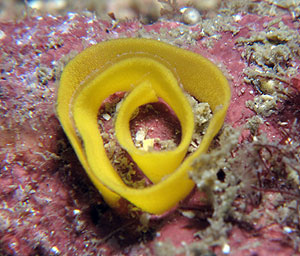Reproduction & Lifecycle
A defining characteristic of most nudibranch species is the ephemeral life style of the animals. Most members of order Nudibranchia are semelparous, meaning the adults undergo a single spawning period and die (Todd, 1981). As most nudibranchs only live for about a year, reaching maturity in a matter of days or weeks, this window for reproduction isn't very large (Rudman, 2000). Due to the short nature of their life spans, mating is opportunistic; occurring whenever mature nudibranchs come in contact with one anther (Todd, 1981). During copulation the mating individuals align head to tail, with right side in proximity to one another. Once the genital papillae of the individuals touch, the penis enters the female duct of the other (Behrens, 2005). At this point nudibranchs exchange sperm packets, which are stored in a seminal receptacle until such a time that environmental conditions are suitable for fertilization (Todd, 1981). Individuals are then capable of depositing their spawn mass on suitable substrate, spiraling in a characteristic counter-clockwise egg ribbon (Rudman, 2000). The larval state that emerges from the egg ribbons a free living veliger larva (Rudman, 2000).

|
| Figure 1. Counter-clockwise spiral egg ribbon (Picture from http://www.nudibranch.com.au) |
These veliger larvae are named for their swimming organ, the velum, which consists of two large, semicircular, ciliated lobes that beat the water for movement. The veliger larva has a hard, protective shell, the shape of this shell varies between species and is often used as a distinguishing characteristic in identifying genera (Todd, 1991). The long cilia of the velum function not only in locomotion, but also in suspension feeding by bringing plankton in contact with the shorted cilia of the subvelar food groove (Ruppert et al, 2004). These larvae swim and drift in the current, sometimes covering hundreds of kilometers until they find a suitable site to anchor and undergo metamorphosis into their adult form. Site selection is crucial because nudibranch species are specialized for life in a specific habitat, and are unlikely to survive in a hostile or new environment (Ruppert et al, 2004).

|
| Figure 2. Veliger larvae (drawing by Micheal G. Hadfield) |
|